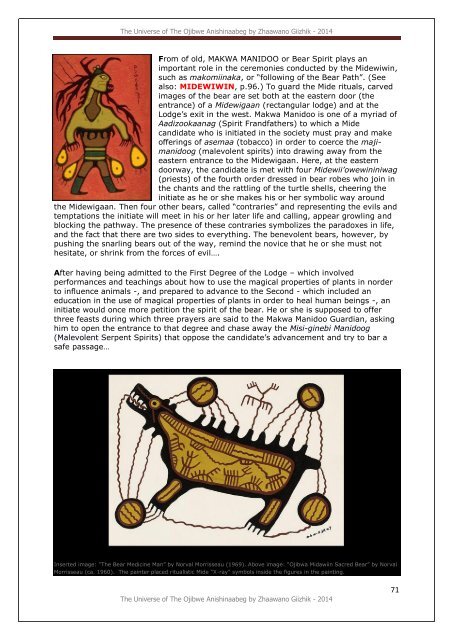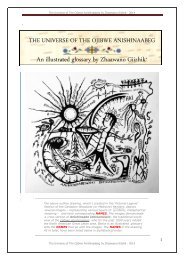The Traditional Anishinaabe World View.pdf
Illustrated glossary offering a cross section of the traditional worldview of the Ojibwe Anishinaabeg, who for the past 1000 years or more inhabit Gaa-zaaga'ekanikaag, the Land of Many Lakes ( the North American Great Lakes area).
Illustrated glossary offering a cross section of the traditional worldview of the Ojibwe Anishinaabeg, who for the past 1000 years or more inhabit Gaa-zaaga'ekanikaag, the Land of Many Lakes ( the North American Great Lakes area).
Create successful ePaper yourself
Turn your PDF publications into a flip-book with our unique Google optimized e-Paper software.
<strong>The</strong> Universe of <strong>The</strong> Ojibwe <strong>Anishinaabe</strong>g by Zhaawano Giizhik - 2014<br />
From of old, MAKWA MANIDOO or Bear Spirit plays an<br />
important role in the ceremonies conducted by the Midewiwin,<br />
such as makomiinaka, or “following of the Bear Path”. (See<br />
also: MIDEWIWIN, p.96.) To guard the Mide rituals, carved<br />
images of the bear are set both at the eastern door (the<br />
entrance) of a Midewigaan (rectangular lodge) and at the<br />
Lodge’s exit in the west. Makwa Manidoo is one of a myriad of<br />
Aadizookaanag (Spirit Frandfathers) to which a Mide<br />
candidate who is initiated in the society must pray and make<br />
offerings of asemaa (tobacco) in order to coerce the majimanidoog<br />
(malevolent spirits) into drawing away from the<br />
eastern entrance to the Midewigaan. Here, at the eastern<br />
doorway, the candidate is met with four Midewii’owewininiwag<br />
(priests) of the fourth order dressed in bear robes who join in<br />
the chants and the rattling of the turtle shells, cheering the<br />
initiate as he or she makes his or her symbolic way around<br />
the Midewigaan. <strong>The</strong>n four other bears, called “contraries” and representing the evils and<br />
temptations the initiate will meet in his or her later life and calling, appear growling and<br />
blocking the pathway. <strong>The</strong> presence of these contraries symbolizes the paradoxes in life,<br />
and the fact that there are two sides to everything. <strong>The</strong> benevolent bears, however, by<br />
pushing the snarling bears out of the way, remind the novice that he or she must not<br />
hesitate, or shrink from the forces of evil….<br />
After having being admitted to the First Degree of the Lodge – which involved<br />
performances and teachings about how to use the magical properties of plants in norder<br />
to influence animals -, and prepared to advance to the Second - which included an<br />
education in the use of magical properties of plants in order to heal human beings -, an<br />
initiate would once more petition the spirit of the bear. He or she is supposed to offer<br />
three feasts during which three prayers are said to the Makwa Manidoo Guardian, asking<br />
him to open the entrance to that degree and chase away the Misi-ginebi Manidoog<br />
(Malevolent Serpent Spirits) that oppose the candidate’s advancement and try to bar a<br />
safe passage…<br />
Inserted image: “<strong>The</strong> Bear Medicine Man” by Norval Morrisseau (1969). Above image: “Ojibwa Midawiin Sacred Bear” by Norval<br />
Morrisseau (ca. 1960). <strong>The</strong> painter placed ritualistic Mide “X-ray” symbols inside the figures in the painting.<br />
<strong>The</strong> Universe of <strong>The</strong> Ojibwe <strong>Anishinaabe</strong>g by Zhaawano Giizhik - 2014<br />
71





